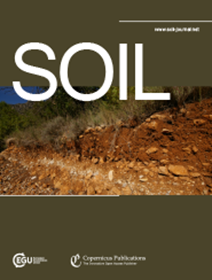Using 3D observations with high spatio-temporal resolution to calibrate and evaluate a process-focused cellular automaton model of soil erosion by water
IF 5.8
2区 农林科学
Q1 SOIL SCIENCE
引用次数: 0
Abstract
Abstract. Future global change is likely to give rise to novel combinations of the factors which enhance or inhibit soil erosion by water. Thus, there is a need for erosion models, necessarily process-focused ones, which are able to reliably represent the rates and extents of soil erosion under unprecedented circumstances. The process-focused cellular automaton erosion model RillGrow is, given initial soil surface microtopography for a plot-sized area, able to predict the emergent patterns produced by runoff and erosion. This study explores the use of structure-from-motion photogrammetry as a means to calibrate and evaluate this model by capturing detailed, time-lapsed data for soil surface height changes during erosion events. Temporally high-resolution monitoring capabilities (i.e. 3D models of elevation change at 0.1 Hz frequency) permit the evaluation of erosion models in terms of the sequence of the formation of erosional features. Here, multiple objective functions using three different spatio-temporal averaging approaches are assessed for their suitability in calibrating and evaluating the model's output. We used two sets of data from field- and laboratory-based rainfall simulation experiments lasting 90 and 30 min, respectively. By integrating 10 different calibration metrics, the outputs of 2000 and 2400 RillGrow runs for, respectively, the field and laboratory experiments were analysed. No single model run was able to adequately replicate all aspects of either the field or the laboratory experiments. The multiple objective function approaches highlight different aspects of model performance, indicating that no single objective function can capture the full complexity of erosion processes. They also highlight different strengths and weaknesses of the model. Depending on the focus of the evaluation, an ensemble of objective functions may not always be necessary. These results underscore the need for more nuanced evaluation of erosion models, e.g. by incorporating spatial-pattern comparison techniques to provide a deeper understanding of the model's capabilities. Such calibrations are an essential complement to the development of erosion models which are able to forecast the impacts of future global change. For the first time, we use data with a very high spatio-temporal resolution to calibrate a soil erosion model.利用高时空分辨率的三维观测来校准和评估以过程为中心的水对土壤侵蚀的元胞自动机模型
摘要。未来的全球变化很可能会产生加强或抑制水对土壤侵蚀的各种因素的新组合。因此,有必要建立侵蚀模型,这些模型必须以过程为中心,能够可靠地表示在前所未有的情况下土壤侵蚀的速率和程度。以过程为中心的元胞自动机侵蚀模型RillGrow在给定一个地块大小区域的初始土壤表面微地形的情况下,能够预测径流和侵蚀产生的涌现模式。本研究探索了利用运动结构摄影测量作为一种手段,通过捕获侵蚀事件期间土壤表面高度变化的详细、延时数据来校准和评估该模型。时间上的高分辨率监测能力(即0.1 Hz频率的高程变化3D模型)允许根据侵蚀特征的形成顺序对侵蚀模型进行评估。本文对使用三种不同时空平均方法的多个目标函数在校准和评估模型输出中的适用性进行了评估。我们使用了两组数据,分别来自野外和实验室的降雨模拟实验,持续时间分别为90和30分钟。通过整合10种不同的校准指标,分别对2000和2400次RillGrow运行的输出进行了现场和实验室试验分析。没有一个单一的模型运行能够充分地复制现场或实验室实验的所有方面。多目标函数方法强调了模型性能的不同方面,表明没有单一的目标函数可以捕捉侵蚀过程的全部复杂性。它们还突出了模型的不同优点和缺点。根据评价的重点,目标函数的集合可能并不总是必要的。这些结果强调需要对侵蚀模型进行更细致的评估,例如,通过结合空间模式比较技术来更深入地了解模型的能力。这种校准是对能够预测未来全球变化影响的侵蚀模式发展的重要补充。我们首次使用具有非常高时空分辨率的数据来校准土壤侵蚀模型。
本文章由计算机程序翻译,如有差异,请以英文原文为准。
求助全文
约1分钟内获得全文
求助全文
来源期刊

Soil
Agricultural and Biological Sciences-Soil Science
CiteScore
10.80
自引率
2.90%
发文量
44
审稿时长
30 weeks
期刊介绍:
SOIL is an international scientific journal dedicated to the publication and discussion of high-quality research in the field of soil system sciences.
SOIL is at the interface between the atmosphere, lithosphere, hydrosphere, and biosphere. SOIL publishes scientific research that contributes to understanding the soil system and its interaction with humans and the entire Earth system. The scope of the journal includes all topics that fall within the study of soil science as a discipline, with an emphasis on studies that integrate soil science with other sciences (hydrology, agronomy, socio-economics, health sciences, atmospheric sciences, etc.).
 求助内容:
求助内容: 应助结果提醒方式:
应助结果提醒方式:


